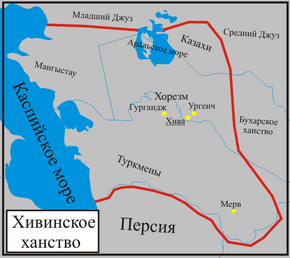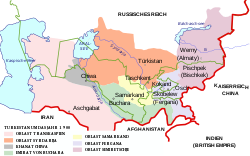Chivský chanát
| Chivský chanát خیوه خانلیگی
| |||||||
Geografie
| |||||||
67 521 km² (rok 1911) | |||||||
| Obyvatelstvo | |||||||
| Státní útvar | |||||||
Vznik | |||||||
Zánik | |||||||
| Státní útvary a území | |||||||
| |||||||
Chivský chanát (uzbecky خیوه خانلیگی – Xiva xonligi; persky خانات خیوه) byl nezávislý a později polonezávislý chanát turkického národa Uzbeků v Asii v oblasti dolního povodí Amudarji. Existoval v letech 1512 až 1920, přičemž v letech 1740–1746 byl okupován perským šáhem Nádirem a od roku 1873 byl protektorátem Ruského impéria. Hlavním městem byl nejprve Kuňja-Urgenč, ale v důsledku změny toku Amudarji v roce 1576 se zhruba do roku 1620 stala hlavním městem Chiva.


V návaznosti na říjnovou revoluci v Rusku abdikoval v únoru 1920 poslední chán a na území chanátu byla 26. dubna 1920 vyhlášena Chórezmská lidová sovětská republika. Ta byla o pár let později rozdělena mezi Turkmenskou SSR a Uzbeckou SSR, z kterých později vznikly moderní Turkmenistán a Uzbekistán.
Externí odkazy
 Obrázky, zvuky či videa k tématu Chivský chanát na Wikimedia Commons
Obrázky, zvuky či videa k tématu Chivský chanát na Wikimedia Commons  Encyklopedické heslo Chíva v Ottově slovníku naučném ve Wikizdrojích
Encyklopedické heslo Chíva v Ottově slovníku naučném ve Wikizdrojích
Média použitá na této stránce
Autor:
- Turkestan_1900-es.svg: Wassily / Translator:Molorco
- derivative work: HylgeriaK (talk)
Russian Turkestan in 1900
Autor: Samhanin, Licence: CC0
Flag of the Khanate of Khiva, "The museum of Khiva displays (vertically) the flag used by the khanate of Khiva during the civil war (1917-1922). The khanate, which had been annexed by Russia in 1873, proclaimed independence on 13 February 1917. In 1918, the khan was overthrown by a Turkmen chief. Then began a period of anarchy. The protectorate of Khiva was suppressed on 9 April 1919 and Khiva was included in the new Republic of Khorezm, created by the Soviets on 26 April 1920."
Flag of the Khorezm People's Soviet Republic
Fictional flag of the Khivan Khanate.
Autor: HetmanTheResearcher, Licence: CC BY 4.0
Own work. Source: Lux-Wurm, P. C., & Zaragoza, Martha. (2001). Les drapeaux de l’islam : de Mahomet à nos jours. Buchet-Chastel. P.252-253.








